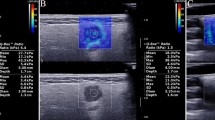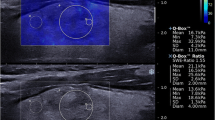Abstract
Objectives
To evaluate shear wave elastography (SWE) for focal lesions in major salivary glands.
Methods
Sixty lesions (49 parotid, 11 submandibular) undergoing routine ultrasound (grey scale and Doppler) also underwent SWE before US-guided needle aspiration for cytology. Quantitative indices of the shear elastic modulus (stiffness) were compared with cytological results.
Results
Fifty-five lesions were benign (21 pleomorphic adenomas, 18 Warthin’s tumours; 16 others) and 5 malignant (2 mucoepidermoid carcinomas, 1 myoepithelial carcinoma, 1 B-cell lymphoma, 1 nodal metastasis). Shear modulus of benign lesions, median 18.3 kPa, overlapped appreciably with malignant lesions, median 13.5 kPa. However, 2 mucoepidermoid carcinomas had the highest stiffness values (81.9 kPa, 132.0 kPa). Stiffness of pleomorphic adenomas (median 22.5 kPa) was higher than Warthin’s tumours (16.9 kPa) (P = 0.05 Mann–Whitney U-test). The standard deviation of stiffness values within a lesion, used as an indicator of spatial heterogeneity, was highest in mucoepidermoid cancers (median 44.2 kPa), followed by pleomorphic adenomas (median 12.4 kPa) and remaining lesions (medians 1.4–10.3 kPa).
Conclusion
This study shows a degree of clustering of SWE indices according to pathology although it appears that SWE has suboptimal performance for ruling out malignancy, thus limiting its use in routine practice.
Key Points
• Shear wave elastography is a feasible technique for focal salivary gland lesions.
• Elastographic artefacts aggravated by the regional anatomy may hinder this technique.
• Elastographic indices vary according to pathology but there is appreciable overlap.
• Overlapping indices for malignant and benign lesions limit its utility.
• Pleomorphic adenomas have higher elasticity indices, i.e. are stiffer, than Warthin’s tumours.






Similar content being viewed by others
References
Salomon G, Kollerman J, Thederan I et al (2008) Evaluation of prostate cancer detection with ultrasound real-time elastography: a comparison with step section pathological analysis after radical prostatectomy. Eur Urol 54:1354–1362
Asteria C, Giovanardi A, Pizzocaro A et al (2008) US-elastography in the differential diagnosis of benign and malignant thyroid nodules. Thyroid 18:523–531
Tranquart F, Bleuzen A, Pierre-Renoult P, Chabrolle C, Sam Giao M, Lecomte P (2008) Elastosonography of thyroid lesions. J Radiol 89:35–39
Bojunga J, Herrmann E, Meyer G, Weber S, Zeuzem S, Friedrich-Rust M (2010) Real-time elastography for the differentiation of benign and malignant thyroid nodules: a meta-analysis. Thyroid 20:1145–1150
Itoh A, Ueno E, Tohno E et al (2006) Breast disease: clinical application of US elastography for diagnosis. Radiology 239:341–350
Burnside ES, Hall TJ, Sommer AM et al (2007) Differentiating benign from malignant solid breast masses with US strain imaging. Radiology 245:401–410
Schaefer FK, Heer I, Schaefer PJ et al (2011) Breast ultrasound elastography–results of 193 breast lesions in a prospective study with histopathologic correlation. Eur J Radiol 77:450–456
Itokawa F, Itoi T, Sofuni A et al (2011) EUS elastography combined with the strain ratio of tissue elasticity for diagnosis of solid pancreatic masses. J Gastroenterol 46:843–853
Iglesias-Garcia J, Larino-Noia J, Abdulkader I, Forteza J, Dominguez-Munoz JE (2010) Quantitative endoscopic ultrasound elastography: an accurate method for the differentiation of solid pancreatic masses. Gastroenterology 139:1172–1180
Lyshchik A, Higashi T, Asato R et al (2005) Elastic moduli of thyroid tissues under compression. Ultrason Imaging 27:101–110
Bhatia KS, Rasalkar DD, Lee YP et al (2010) Evaluation of real-time qualitative sonoelastography of focal lesions in the parotid and submandibular glands: applications and limitations. Eur Radiol 20:1958–1964
Tanter M, Bercoff J, Athanasiou A et al (2008) Quantitative assessment of breast lesion viscoelasticity: initial clinical results using supersonic shear imaging. Ultrasound Med Biol 34:1373–1386
Bercoff J, Tanter M, Fink M (2004) Supersonic shear imaging: a new technique for soft tissue elasticity mapping. IEEE Trans Ultrason Ferroelectr Freq Control 51:396–409
Sebag F, Vaillant-Lombard J, Berbis J et al (2010) Shear wave elastography: a new ultrasound imaging mode for the differential diagnosis of benign and malignant thyroid nodules. J Clin Endocrinol Metab 95:5281–5288
Athanasiou A, Tardivon A, Tanter M et al (2010) Breast lesions: quantitative elastography with supersonic shear imaging–preliminary results. Radiology 256:297–303
Evans A, Whelehan P, Thomson K et al (2010) Quantitative shear wave ultrasound elastography: initial experience in solid breast masses. Breast Cancer Res 12:R104
Dimitriu D (2008) Ultrasound Elastography features of Major Salivary Gland Tumors. Radiological Society of North America 94th Scientific Assembly and Annual Meeting, Chicago
Dumitriu D, Dudea SM, Botar-Jid C, Baciut G (2010) Ultrasonographic and sonoelastographic features of pleomorphic adenomas of the salivary glands. Med Ultrason 12:175–183
Arda K, Ciledag N, Aktas E, Aribas BK, Kose K (2011) Quantitative assessment of normal soft-tissue elasticity using shear-wave ultrasound elastography. AJR Am J Roentgenol 197:532–536
Author information
Authors and Affiliations
Corresponding author
Rights and permissions
About this article
Cite this article
Bhatia, K.S.S., Cho, C.C.M., Tong, C.S.L. et al. Shear wave elastography of focal salivary gland lesions: preliminary experience in a routine head and neck US clinic. Eur Radiol 22, 957–965 (2012). https://doi.org/10.1007/s00330-011-2364-3
Received:
Revised:
Accepted:
Published:
Issue Date:
DOI: https://doi.org/10.1007/s00330-011-2364-3




